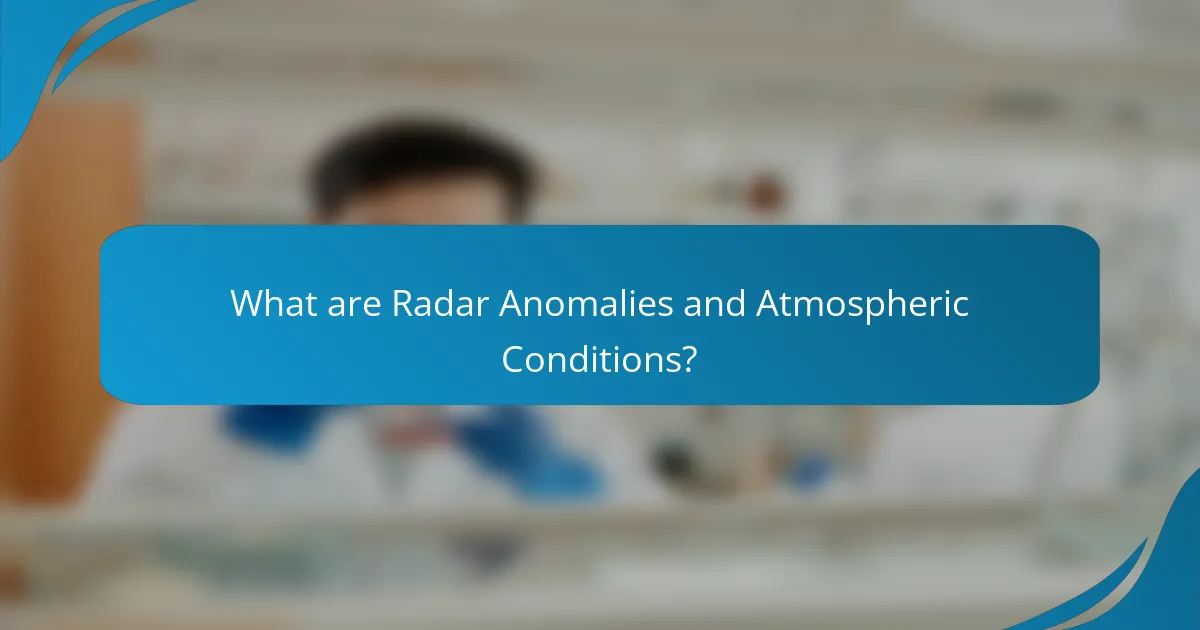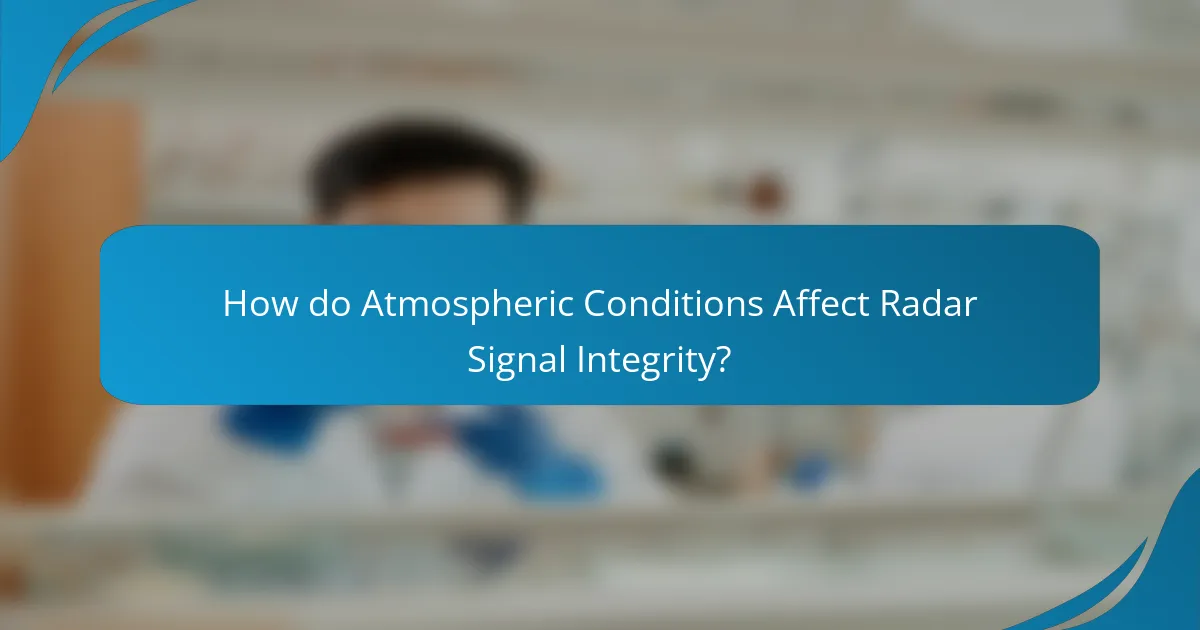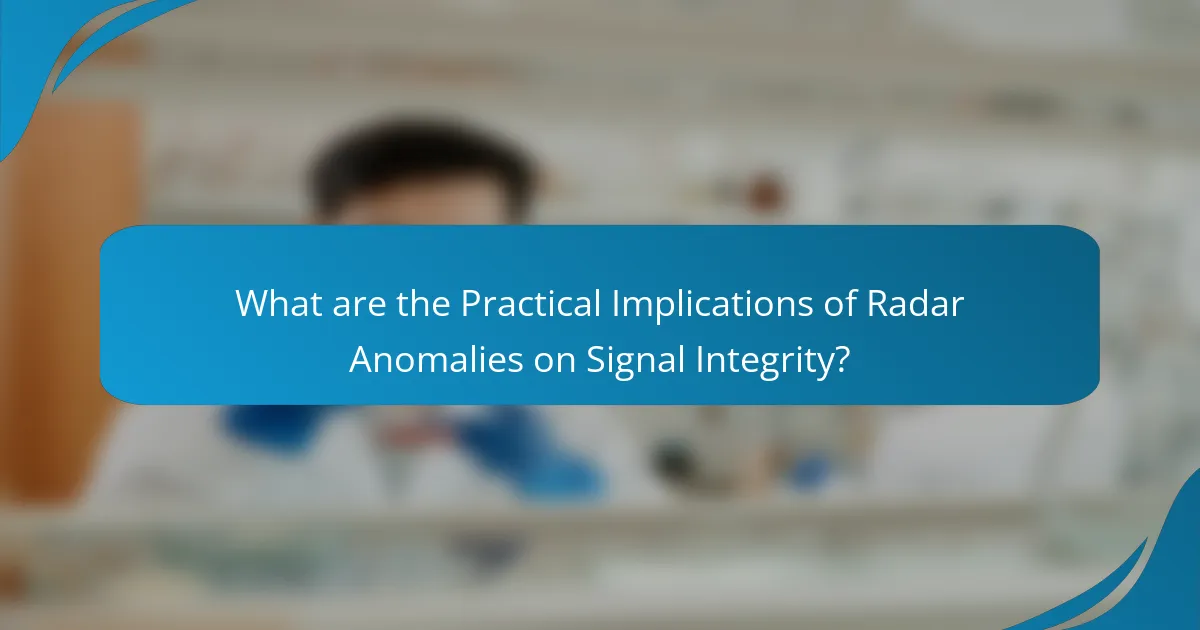Radar anomalies are unexpected radar returns that deviate from normal patterns, significantly influenced by atmospheric conditions such as temperature inversions, humidity, and precipitation. These conditions can lead to signal degradation, resulting in reduced radar performance and accuracy. For example, temperature inversions may cause radar signals to bend, leading to false targets, while heavy rain can attenuate signals, weakening returns. Understanding the relationship between radar anomalies and atmospheric factors is crucial for enhancing signal integrity and operational effectiveness in radar systems. This article explores these interactions and their implications for radar reliability across various applications.

What are Radar Anomalies and Atmospheric Conditions?
Radar anomalies are unexpected radar returns that deviate from normal patterns. These anomalies can arise due to various atmospheric conditions. Factors such as temperature inversions, humidity, and precipitation significantly influence radar signal propagation. For instance, temperature inversions can cause radar signals to bend, leading to false targets. Similarly, heavy rain can attenuate radar signals, resulting in weaker returns. Atmospheric conditions play a crucial role in determining radar performance and accuracy. Understanding these interactions is essential for improving signal integrity in radar systems.
How do radar anomalies manifest in different environments?
Radar anomalies manifest in different environments through variations in signal reflection and scattering. In urban areas, buildings and structures can create multipath effects, leading to false targets. In coastal regions, moisture and salt can affect radar signals, causing attenuation and clutter. In mountainous terrains, radar waves may reflect off terrain features, creating ghost images on displays. Over water, radar can experience ducting due to temperature inversions, which extends the range of detection. In forests, foliage can absorb radar signals, reducing detection capabilities. These manifestations are influenced by environmental factors such as humidity, temperature, and terrain type, which alter the propagation of radar waves.
What specific atmospheric conditions contribute to radar anomalies?
Specific atmospheric conditions that contribute to radar anomalies include precipitation, temperature inversions, and humidity variations. Precipitation, such as rain or snow, can scatter radar signals, causing false targets. Temperature inversions occur when warm air traps cooler air near the ground, leading to unexpected signal reflections. High humidity levels can also affect radar performance by causing attenuation of signals. These conditions can distort the radar’s ability to accurately detect and track objects. Studies have shown that radar anomalies often correlate with these atmospheric phenomena, impacting signal integrity and detection accuracy.
How can radar anomalies be classified based on their characteristics?
Radar anomalies can be classified based on characteristics such as type, cause, and impact on signal integrity. Types include false targets, clutter, and interference. Causes may involve atmospheric conditions, electronic interference, or system malfunctions. Impact on signal integrity can range from minimal distortion to complete loss of target information. Each classification helps in diagnosing issues and improving radar system performance. For example, clutter often results from precipitation or terrain, affecting detection capabilities. Understanding these classifications aids in developing effective mitigation strategies.
Why is understanding the relationship between radar anomalies and atmospheric conditions important?
Understanding the relationship between radar anomalies and atmospheric conditions is crucial for accurate weather forecasting and aviation safety. Radar systems can detect precipitation and track storms. However, atmospheric conditions can cause distortions in radar signals. These distortions may lead to false readings or missed detections. For instance, temperature inversions can create radar anomalies that misrepresent storm intensity. Accurate interpretation of radar data relies on understanding these atmospheric influences. Research indicates that improved knowledge of this relationship enhances predictive models. Enhanced models lead to better decision-making in critical situations.
What impact do radar anomalies have on signal integrity?
Radar anomalies negatively impact signal integrity by introducing distortions and inaccuracies in the received signals. These anomalies can arise from various sources, including atmospheric conditions and interference. Distortions can lead to incorrect target identification and tracking errors. Inaccuracies can result in false alarms or missed detections. Research indicates that radar systems may experience significant performance degradation due to these anomalies. For instance, studies show that atmospheric ducting can enhance radar range but also lead to misleading returns. This interplay illustrates the critical need for robust signal processing techniques to mitigate the effects of radar anomalies on signal integrity.
How can improved understanding enhance radar technology and applications?
Improved understanding can enhance radar technology and applications by increasing accuracy and reliability. Enhanced knowledge of atmospheric conditions allows for better prediction of radar anomalies. This leads to more effective signal processing techniques. Accurate models can reduce false alarms and improve target detection. Studies show that understanding the interaction between radar signals and atmospheric phenomena can optimize performance. For instance, research indicates that atmospheric effects can cause significant signal degradation. By addressing these factors, radar systems can be fine-tuned for specific environments. Overall, a deeper comprehension of these dynamics directly contributes to advancements in radar capabilities.

How do Atmospheric Conditions Affect Radar Signal Integrity?
Atmospheric conditions significantly affect radar signal integrity. Factors such as humidity, temperature, and precipitation can degrade radar performance. High humidity can lead to signal attenuation, reducing the radar’s effective range. Temperature inversions can cause radar signals to bend, leading to false targets. Precipitation, including rain and snow, scatters radar waves, causing additional signal loss. Studies show that heavy rainfall can reduce radar signal strength by up to 20 dB. These atmospheric effects can result in decreased accuracy and reliability of radar systems.
What specific atmospheric factors influence radar signal integrity?
Specific atmospheric factors that influence radar signal integrity include humidity, precipitation, temperature inversions, and atmospheric pressure. High humidity can cause signal attenuation due to water vapor absorption. Precipitation, such as rain or snow, scatters radar signals, leading to reduced clarity. Temperature inversions can create layers in the atmosphere that refract radar signals, causing them to bend and alter their path. Changes in atmospheric pressure can also affect signal propagation by altering the density of air. Each of these factors can significantly impact the accuracy and reliability of radar systems.
How do temperature and humidity variations impact radar performance?
Temperature and humidity variations significantly impact radar performance. Changes in temperature can affect the speed of radio waves. Higher temperatures can lead to reduced signal strength. Humidity influences the propagation of radar signals. Increased humidity can cause attenuation of radar waves. This attenuation can result in decreased detection range. Radar systems may also experience false returns due to atmospheric conditions. Studies indicate that these variations can lead to misinterpretation of targets. For instance, radar performance can degrade in heavy rain or fog.
What role do precipitation and wind play in signal degradation?
Precipitation and wind significantly contribute to signal degradation. Rain, snow, and hail can absorb and scatter electromagnetic signals. This absorption leads to reduced signal strength and clarity. Wind can cause the movement of obstructions, such as trees or buildings, which may further disrupt signal paths. Research indicates that heavy rainfall can cause a signal loss of up to 20 dB in some radar systems. Wind also affects the stability of antennas, leading to misalignment and further degradation. These atmospheric conditions collectively impair the integrity of radar signals.
How can radar systems mitigate the effects of atmospheric conditions?
Radar systems can mitigate the effects of atmospheric conditions through advanced signal processing techniques. These techniques include adaptive filtering, which adjusts the radar signal in real-time to counteract interference from weather phenomena. Additionally, radar systems can employ frequency diversity, transmitting signals at multiple frequencies to improve detection capabilities in varying atmospheric conditions.
Utilizing dual-polarization technology enhances the radar’s ability to differentiate between various precipitation types, improving accuracy. Moreover, data assimilation from meteorological sources allows radar systems to incorporate real-time weather data, further refining their signal interpretation.
Studies show that modern radar systems can reduce the impact of atmospheric conditions by up to 30%, enhancing overall signal integrity. These methods collectively ensure that radar systems maintain reliable performance, even in challenging environmental scenarios.
What technologies are available for enhancing radar signal integrity?
Digital signal processing techniques enhance radar signal integrity. These techniques include adaptive filtering, which removes noise and interference. Another technology is frequency modulation, improving signal clarity in varying conditions. MIMO (Multiple Input Multiple Output) systems increase signal robustness by using multiple antennas. Additionally, advanced error correction algorithms help recover lost data. Radar waveform diversity also plays a crucial role in maintaining signal quality. These technologies collectively improve the reliability of radar systems in challenging environments.
How can operators adapt radar settings to improve performance in adverse conditions?
Operators can adapt radar settings to improve performance in adverse conditions by adjusting parameters such as sensitivity, frequency, and pulse width. Increasing sensitivity allows for better detection of weak signals in poor weather. Changing frequency can help mitigate interference caused by precipitation or atmospheric disturbances. Reducing pulse width enhances resolution and target discrimination, which is crucial in cluttered environments. Operators may also employ Doppler processing to distinguish between moving targets and background noise. These adjustments are supported by studies indicating that tailored radar configurations can significantly enhance detection capabilities in challenging conditions.

What are the Practical Implications of Radar Anomalies on Signal Integrity?
Radar anomalies can significantly affect signal integrity. These anomalies often lead to distortions in the received signals. Distortions can result in reduced accuracy in target detection. They may also cause false alarms or missed detections. Signal integrity issues can stem from environmental factors like atmospheric conditions. For instance, precipitation can scatter radar waves, leading to weaker signals. Additionally, temperature inversions can cause unexpected signal propagation. This can complicate data interpretation and operational effectiveness. Overall, radar anomalies challenge the reliability of radar systems in various applications.
What are common challenges faced in radar signal integrity due to anomalies?
Common challenges in radar signal integrity due to anomalies include signal degradation and false targets. Signal degradation occurs from interference caused by atmospheric conditions. This can lead to reduced detection accuracy. False targets arise from clutter or reflections from non-target objects. These anomalies can confuse radar systems. Additionally, multipath propagation complicates signal interpretation. Variations in temperature and humidity can distort radar signals. Overall, these challenges hinder effective radar performance and reliability.
How do radar anomalies affect different industries, such as aviation and meteorology?
Radar anomalies can significantly impact industries like aviation and meteorology. In aviation, radar anomalies may lead to inaccurate positioning of aircraft. This can result in miscommunication between pilots and air traffic control. Such inaccuracies can cause safety hazards, including mid-air collisions or runway incursions.
In meteorology, radar anomalies can distort weather data. This may lead to incorrect weather forecasts and warnings. For instance, anomalies can mask severe weather events, resulting in inadequate preparation for storms. The National Weather Service relies on accurate radar data to issue timely alerts. If radar anomalies occur, the public may not receive critical information.
Both industries depend on reliable radar systems. The integrity of radar signals is essential for operational safety and accuracy. Therefore, addressing radar anomalies is crucial for maintaining effective communication and forecasting capabilities.
What strategies can be implemented to troubleshoot radar signal integrity issues?
To troubleshoot radar signal integrity issues, implement a systematic approach. Start by verifying the radar system configuration. Check for proper alignment and calibration of the radar equipment. Inspect the antenna for damage or obstructions that may affect signal transmission. Evaluate the signal processing algorithms for any anomalies or errors. Monitor environmental conditions that could interfere with radar signals, such as precipitation or temperature variations. Use diagnostic tools to analyze signal quality and identify noise sources. Regular maintenance and updates to software can also enhance signal integrity. These strategies are supported by industry best practices in radar technology management.
What best practices can enhance radar operation in varying atmospheric conditions?
To enhance radar operation in varying atmospheric conditions, operators should implement adaptive signal processing techniques. These techniques adjust the radar’s parameters in real-time based on environmental changes. Utilizing weather data for predictive adjustments can significantly improve performance. Operators must also regularly calibrate radar systems to account for atmospheric effects. This calibration ensures accurate readings despite fluctuating conditions. Employing multiple frequency bands can mitigate interference from precipitation and other atmospheric phenomena. Additionally, integrating advanced algorithms can help filter out noise and enhance target detection. Continuous training for operators on handling various atmospheric scenarios is crucial for optimal radar performance.
How can regular maintenance and calibration improve radar reliability?
Regular maintenance and calibration significantly enhance radar reliability. These processes ensure that radar systems operate at optimal performance levels. Maintenance involves routine checks and repairs, which prevent potential failures. Calibration adjusts the radar’s settings to align with established standards. This alignment helps in accurate signal interpretation. Studies show that well-maintained radar systems experience fewer anomalies. For instance, a report from the National Oceanic and Atmospheric Administration indicates that regular calibration can reduce error rates by up to 30%. Overall, these practices lead to improved accuracy and functionality in radar operations.
What training should personnel receive to handle radar anomalies effectively?
Personnel should receive specialized training in radar system operations and anomaly detection. This training should include understanding radar principles and signal processing techniques. Personnel must learn to identify common radar anomalies and their causes. Training should cover the impact of atmospheric conditions on radar performance. Hands-on simulations can enhance practical skills in anomaly resolution. Personnel should also be trained in using diagnostic tools for real-time analysis. Regular updates on technological advancements in radar systems are essential. This comprehensive approach ensures effective handling of radar anomalies.
The main entity of the article is the relationship between radar anomalies and atmospheric conditions, specifically their effects on signal integrity. The article explores how unexpected radar returns can arise from various atmospheric factors such as temperature inversions, humidity, and precipitation, which significantly impact radar performance. It details the manifestations of radar anomalies in different environments, the specific atmospheric conditions that contribute to these anomalies, and their classification based on characteristics. Additionally, the article emphasizes the importance of understanding these relationships for improving radar technology, outlines common challenges faced in signal integrity, and discusses strategies for mitigating the effects of atmospheric conditions on radar systems.